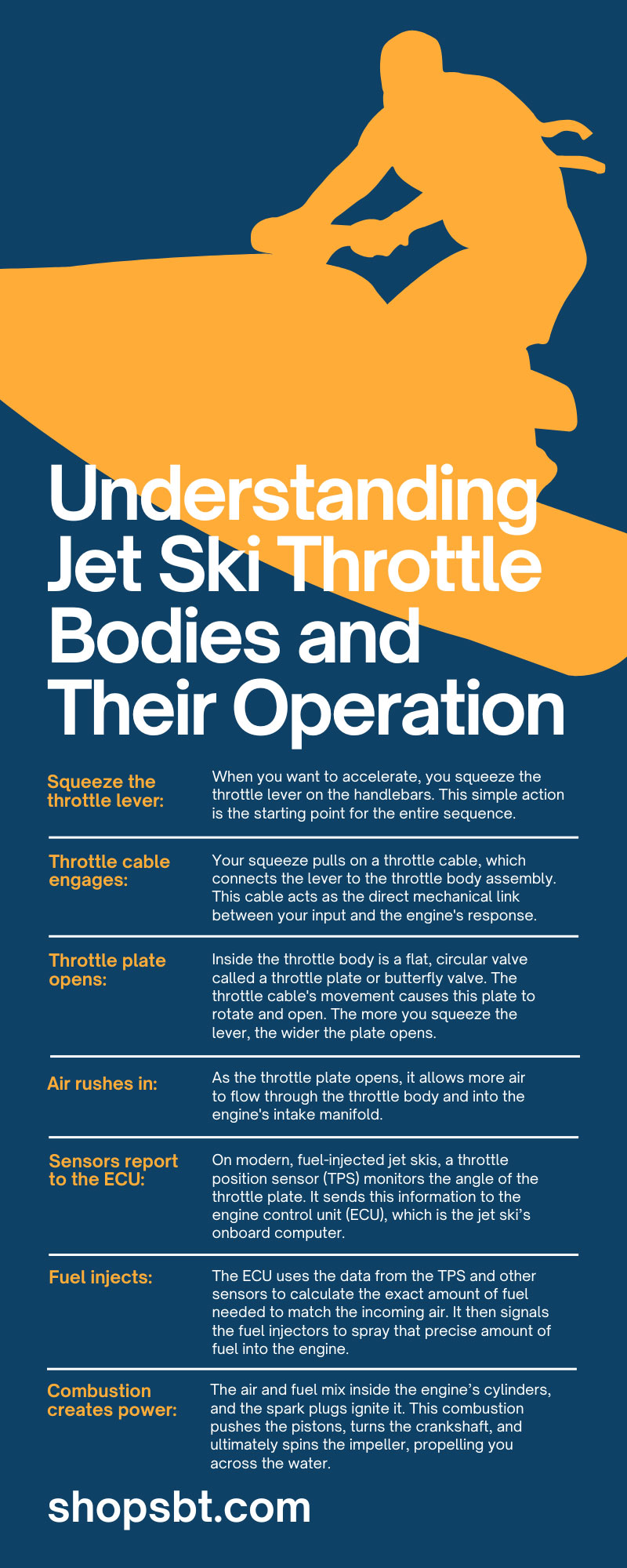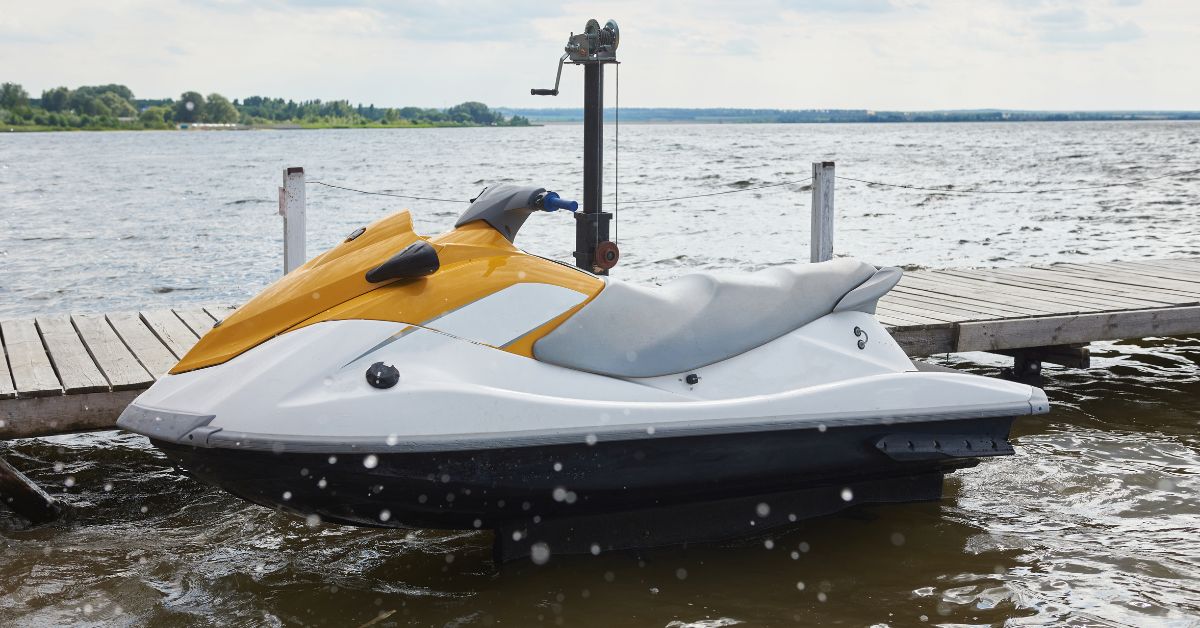Understanding Jet Ski Throttle Bodies and Their Operation
Riding a jet ski offers an exhilarating feeling of freedom and power on the water. A considerable part of that power comes from how you control the engine's speed, which all happens thanks to a critical component: the throttle body. While it might sound technical, understanding your jet ski’s throttle body is key to keeping your watercraft running at its best.
Knowing how this part works helps you diagnose issues, perform basic maintenance, and make informed decisions about potential upgrades. This guide will aid you in understanding jet ski throttle bodies and their operation, from their basic function to troubleshooting common problems.
How a Jet Ski Throttle Body Works
So, what exactly does a throttle body do? In simple terms, the throttle body is the gateway for air entering your jet ski's engine. Your engine needs a precise mixture of air and fuel to create combustion and generate power. The throttle body’s main job is to regulate the amount of air that gets into the engine, directly controlling its speed and power output.
Here’s a step-by-step look at the process:
- Squeeze the throttle lever: When you want to accelerate, you squeeze the throttle lever on the handlebars. This simple action is the starting point for the entire sequence.
- Throttle cable engages: Your squeeze pulls on a throttle cable, which connects the lever to the throttle body assembly. This cable acts as the direct mechanical link between your input and the engine's response.
- Throttle plate opens: Inside the throttle body is a flat, circular valve called a throttle plate or butterfly valve. The throttle cable's movement causes this plate to rotate and open. The more you squeeze the lever, the wider the plate opens.
- Air rushes in: As the throttle plate opens, it allows more air to flow through the throttle body and into the engine's intake manifold.
- Sensors report to the ECU: On modern, fuel-injected jet skis, a throttle position sensor (TPS) monitors the angle of the throttle plate. It sends this information to the engine control unit (ECU), which is the jet ski’s onboard computer.
- Fuel injects: The ECU uses the data from the TPS and other sensors to calculate the exact amount of fuel needed to match the incoming air. It then signals the fuel injectors to spray that precise amount of fuel into the engine.
- Combustion creates power: The air and fuel mix inside the engine’s cylinders, and the spark plugs ignite it. This combustion pushes the pistons, turns the crankshaft, and ultimately spins the impeller, propelling you across the water.
Common Issues With Jet Ski Throttle Bodies
Like any mechanical part, throttle bodies can develop problems over time. Spotting the symptoms early can save you from a frustrating day and potentially expensive repairs.
Identifying Common Problems
There are several signs to watch out for that could indicate your throttle body needs attention. Watch for these warning signs so that you can address potential issues before they become serious problems.
- Rough idling: Jet ski sputtering, stalling, or inconsistent idling may result from a dirty throttle body, carbon buildup, or a faulty sensor.
- Poor acceleration: Hesitation when squeezing the throttle could mean a dirty throttle body or faulty Throttle Position Sensor (TPS), causing the ECU to miscalculate fuel delivery.
- High fuel consumption: A faulty throttle body sensor can cause the ECU to inject excess fuel, leading to faster fuel consumption.
- Stalling engine: Frequent stalling at low speeds or stops can result from grime interfering with the throttle plate's movement.
- Check engine light: A "Check Engine" light on a jet ski often signals an issue, with the ECU storing a fault code to help diagnose problems, usually related to the throttle body or sensors.
Simple Troubleshooting Tips
If you suspect a throttle body issue, here are a few things you can check yourself:
- Visual inspection: Start with a simple visual check. Look for any obvious signs of damage, loose connections, or a frayed throttle cable.
- Listen to your jet ski: Pay close attention to how the engine sounds at idle and during acceleration. Unusual noises or changes in performance can provide clues.
- Check the throttle lever: The throttle lever should operate smoothly without sticking. If it feels stiff or gritty, the problem could be the cable or the throttle plate itself.
- Inspect for carbon buildup: You may be able to see carbon deposits around the throttle plate by removing the air intake hose. A significant amount of black gunk is a clear sign that a cleaning is in order.
Maintaining Your Jet Ski Throttle Body
Proper maintenance is the best way to prevent throttle body problems and ensure your jet ski performs reliably. A clean throttle body allows for precise airflow control, which translates to a responsive engine and better fuel efficiency.
Best Practices for Cleaning and Maintenance
Cleaning your throttle body is a maintenance task that many owners can perform themselves with the right tools and a little care.
- Gather your supplies: You'll need a throttle body cleaner spray, soft cloths, and basic tools to remove the air intake hose.
- Access the throttle body: Disconnect the battery, then remove the air intake tube or airbox to expose the throttle plate.
- Clean with care: Spray cleaner onto a cloth and gently wipe the throttle body and plate, manually opening it if needed, to clean without damaging sensors.
- Avoid harsh scrubbing: Use a soft cloth or gentle brush to clean the throttle body and avoid abrasive materials that could cause scratches and disrupt airflow.
- Reassemble and test: Reattach the air intake hose, reconnect the battery, and let the engine idle for a few minutes as the ECU recalibrates.
Upgrading Your Jet Ski Throttle Body
For performance enthusiasts looking to get more power and speed out of their watercraft, upgrading the throttle body is a popular modification. A larger-diameter throttle body can significantly increase airflow to the engine, which, when paired with other upgrades, can unlock substantial horsepower gains.
Benefits of Upgrading
- Increased airflow: Increased airflow is especially important for supercharged or modified engines that demand a higher volume of air.
- Improved throttle response: A high-performance throttle body can provide a quicker and more direct engine response when you hit the throttle.
- Higher horsepower: More air, combined with more fuel and proper tuning, equals more power. An upgraded throttle body is often a key component in a "Stage 1" or "Stage 2" performance kit.
Keep Your Jet Ski Running Smoothly
Your jet ski's throttle body is a small but mighty component that plays a massive role in your watercraft's performance and reliability. From providing crisp acceleration to maintaining a steady idle, its proper function is essential for a great time on the water. By understanding jet ski throttle bodies and their operation, recognizing the signs of trouble, and performing regular maintenance, you can keep your engine running smoothly for years to come.
And remember, the connection between your hand and the engine starts with the throttle cable. If yours feels anything less than perfect, check out the high-quality jet ski throttle cables from SBT to restore that factory-fresh feel and control.



No Comments Yet